
Georgian Sterling Silver Racing Greyhound Signature Seal by Thomas Smith
Georgian sterling silver signature seal maker's mark to Thomas Smith, Birmingham circa 1819, seal figure of a racing greyhound to base, length 9 cm Ex pencil holder.

19th Century Antique Gold Pencil with Turquoise and Amethyst Seal
An antique 15ct gold retractable pencil, adorned with polished turquoise and amethyst seal top, 19th century, 5 cm long
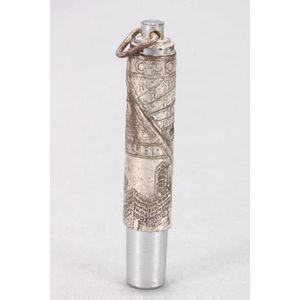
Silver and Amethyst Seal Top Propelling Pencil by Wilmot & Co
Silver and Amythest seal top propelling pencil, unmarked, by Wilmot & Co., of hexagonal form, set with amythest seal top, decorated with acanthus motifs in relief to top, with incised flower and foliage pattern to body, total weight 16gm, length 9.5 cm-12…
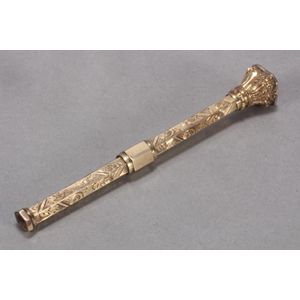
10ct Gold Garnet Seal Top Propelling Pencil, Acanthus Motifs
10ct gold and garnet seal top propelling pencil, unmarked (tested as 10ct), of hexagonal form, set with garnet seal to top, above acanthus motifs in relief, with incised acanthus pattern to body, total weight 12gm (weighted), length 9 cm-11 cm
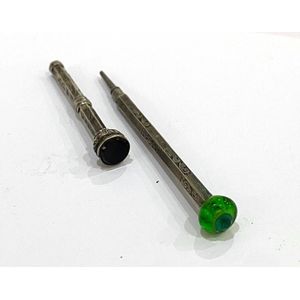
Sterling Silver Propelling Pencils, Webb Birmingham, c.1885
Two sterling silver propelling pencils, one miniature with agate seal top, Francis Webb, Birmingham, c.1885, the other with later Addition green bead finial, filigree detail, column finial, length 5.5-8 cm
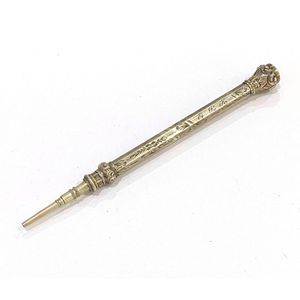
Sterling Silver Carnelian Seal Top Propelling Pencil with Filigree Detail
A sterling silver, carnelian seal top propelling pencil, filigree detail, column finial, engraved initials to body Erk, length 9 cm
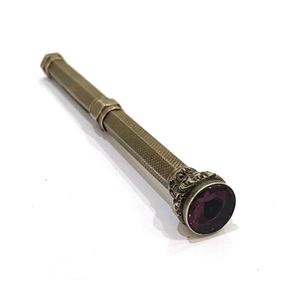
Filigree Amethyst Propelling Pencil
A sterling silver, amethyst seal top propelling pencil, filigree detail, column finial, length 9.5 cm
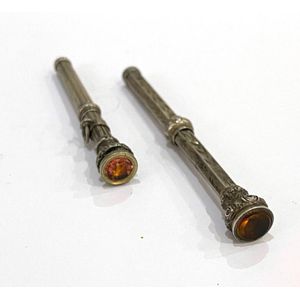
Sterling Silver Citrine & Glass Mini Pencils
Two miniature sterling silver, citrine & glass seal top propelling pencils, length 5-6 cm
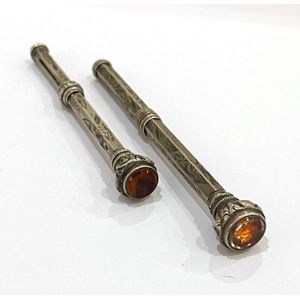
Filigree Citrine Pencils with Glass Seal Top
Two sterling silver, citrine & glass seal top propelling pencils, filigree detail, length 8 cm
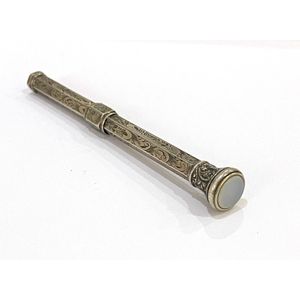
Sterling Silver Agate Propelling Pencil with Filigree Detail
A sterling silver, agate seal top propelling pencil, filigree detail, length 9 cm
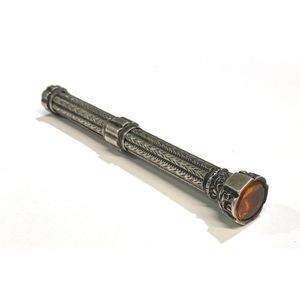
Ridged Citrine Seal Top Pencil in Sterling Silver
A sterling silver, citrine seal top propelling pencil, with ridged engraved detail, length 10.5 cm
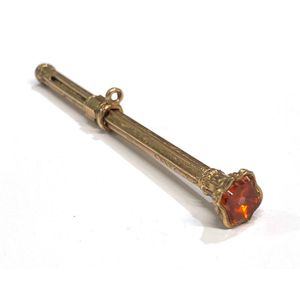
Orange Gold Pencil with Filigree Finial
A gold lined, orange glass seal top propelling pencil, ridged detail, column filigree finial, length 8 cm
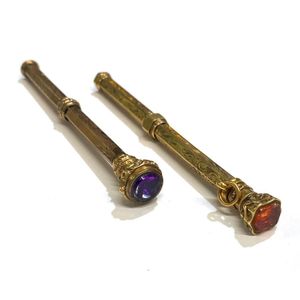
Gold and Glass Propelling Pencils with Filigree Detail
Two gold lined, purple & orange glass seal top propelling pencils, filigree detail, column finial, length 8 cm

Gold-lined agate & glass seal top propelling pencils
Two gold lined, agate & purple glass seal top propelling pencils, engraved filigree detail, column finial, length 9.5 cm
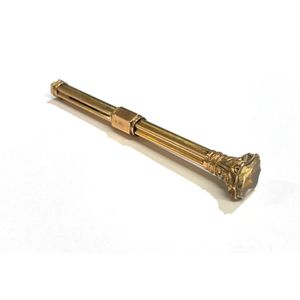
Gold and Orange Filigree Propelling Pencil
A gold lined, orange glass seal top propelling pencil, ridged detail, filigree column finial, length 9.5 cm

Miniature Gold & Gemstone Seal Top Pencils
Two miniature gold lined, bloodstone & carnelian seal top propelling pencils, length 4-5.5 cm
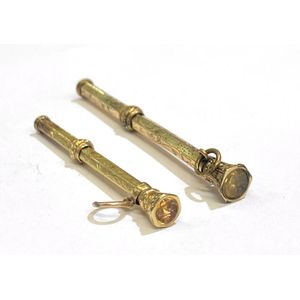
Miniature Citrine Seal Top Propelling Pencils
Two miniature gold lined, citrine seal top propelling pencils, length 5-6.5 cm

Gold-lined Glass Seal Top Propelling Pencils - Miniature Pair
Two miniature gold lined, glass seal top propelling pencils, length 4 cm

Miniature Gold & Turquoise Propelling Pencils
Two miniature gold lined, citrine & glass seal top propelling pencils with turquoise detail, length 4-4.5 cm
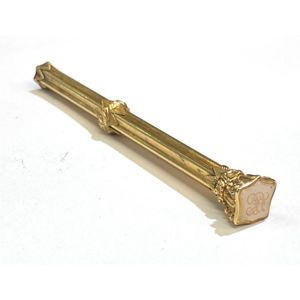
Gold-lined Agate Seal Pencil with Engraved Initials
A gold lined, agate seal top propelling pencil, ridged detail, column, final, engraved initials to seal, length 8.5 cm

Gold-lined amethyst seal top propelling pencil by Sampson Mordan
A Sampson Mordan & Co, gold lined amethyst seal top propelling pencil, length 8.5 cm
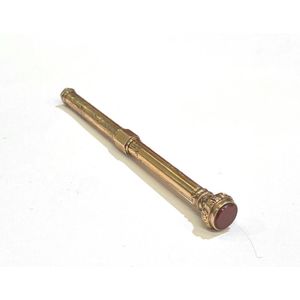
Gold and Carnelian Filigree Propelling Pencil
A gold lined, carnelian seal top propelling pencil, engraved filigree detail, column finial, length 9.5 cm
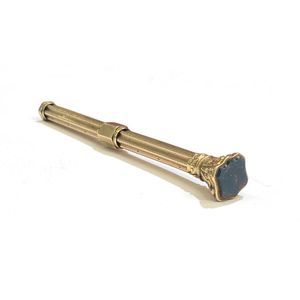
Gold Bloodstone Propelling Pencil with Filigree Finial
A gold lined, bloodstone seal top propelling pencil, engine turned pattern, filigree column finial, length 9.5 cm
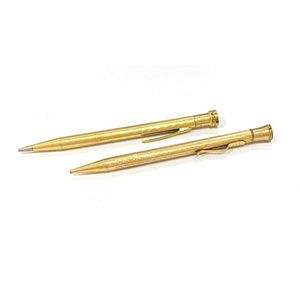
Gold-filled and Ceramic Propelling Pencils with Arrow and Crest
Two propelling pencils including an arrow, USA 14ct gold filled & a rolled gold with ceramic crest seal top, length 13 cm
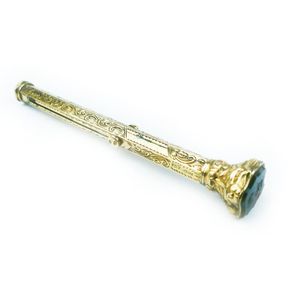
Gold Pencil with Blood Stone Seal and Floral Engraving
Propelling pencil in 9ct yellow gold with shield shaped blood stone seal and floral engraved body circa late 19th century.
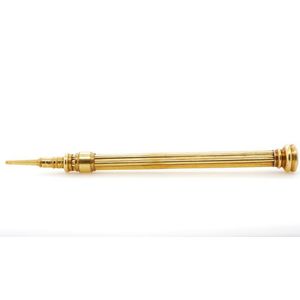
Sampson Mordan Mechanical Pencil with Bloodstone Seal
Sampson Mordan mechanical pencil yellow metal set with a bloodstone seal. Marked S. Mordan & Co makers. Approx length 11 cm
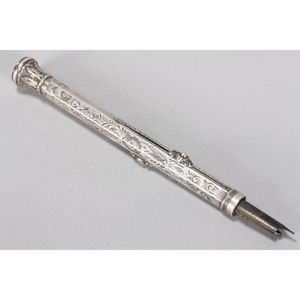
Victorian Sterling Silver Dual Propelling Pencil and Nib
Victorian sterling silver dual propelling pencil and Nib, of facetted form, set with seal top and engraved with acanthus, with cast dual mounts, length 11.5 cm
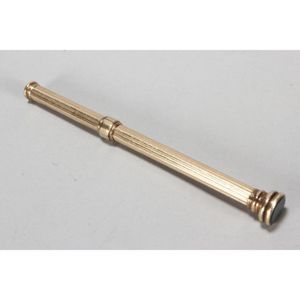
Victorian 14ct Gold Pencil with Agate Seal
Victorian 14ct gold pencil, of slender form with reeded body and agate seal, total weight 7.67gm, height 8 cm
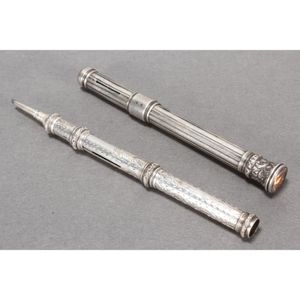
Victorian Sterling Silver Propelling Pencils with Seal Tops
Two Victorian sterling silver propelling pencils, set with seal top, above reeded and engraved bodies, length 9.5 cm and 11 cm (2)
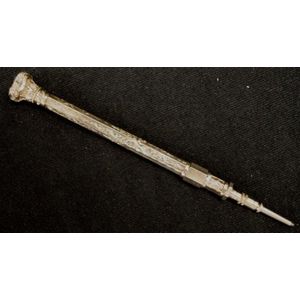
Antique Gold Pencil with Bloodstone Seal
Antique gold lined propelling pencil with bloodstone seal end, length 12.5 cm
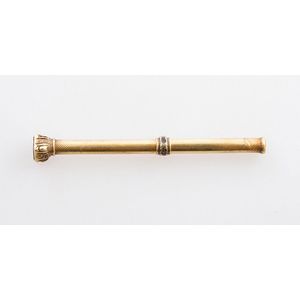
Hardstone Seal Propelling Pencil (Faults)
15ct propelling pencil, inset hardstone seal to the top (faults)
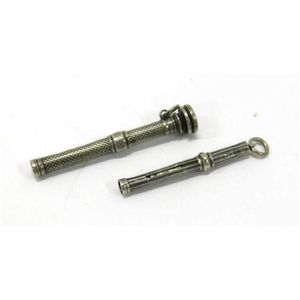
Sterling Silver Telescopic Pencils, S Mordan & Co
Two sterling silver telescopic pencils including a S Mordan & Co, one with reeded body, hallmarks worn, c1900, the other S Mordan & Co solid seal top, engine turned body, length 4 cm and 4.5 cm
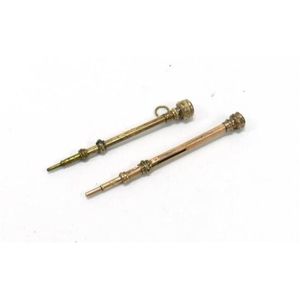
3 Gold Telescopic Pencils with Gemstones and Engraving
Two 9ct rose gold telescopic pencils with a bloodstone and blue paste gemstone finial, a 9ct gold (tested) seal top telescopic pencil, engraved body, 5.5 cm L, total weight 2gms, length 5.5 cm Wt 3.7 grams
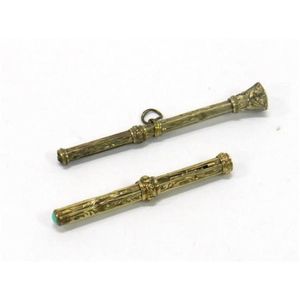
Telescopic Pencils: Gold & Gemstone Miniatures
Two miniature telescopic pencils, one in 14ct yellow gold with a turquoise finial, the other in 9ct yellow gold with a agate seal, length 4.5 cm and 5 cm Wt 5.3 grams
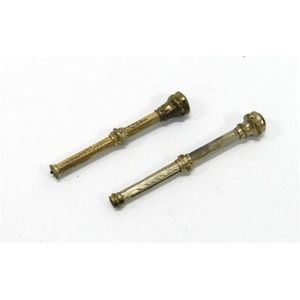
Miniature Telescopic Pencils with Gemstone Seals
Two miniature telescopic pencils with an amethyst and garnet seal top, length 4 cm and 5 cm

Victorian Propelling Pencils with Seal and Watch Key
Two Victorian fancy propelling pencils, with small seal and seal/pocket watch key
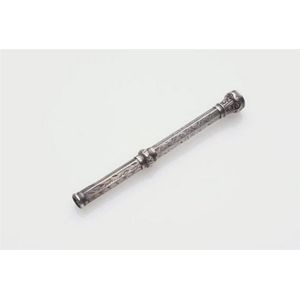
Sterling Silver Seal Top Telescopic Pencil, 9.5cm
A seal top sterling silver telescopic pencil, 9.5 cm long
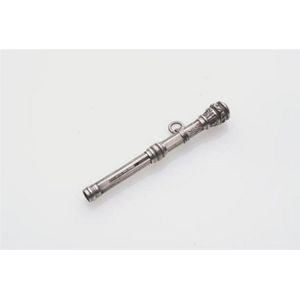
Birmingham 1908 Sterling Silver Telescopic Pencil with Seal Top
A seal top sterling silver (hallmarked) miniature telescopic pencil, Birmingham 1908, 6 cm long

Miniature Amethyst Seal Top Telescopic Pencil (4cm)
A miniature seal top telescopic pencil, amethyst inset, 4 cm long
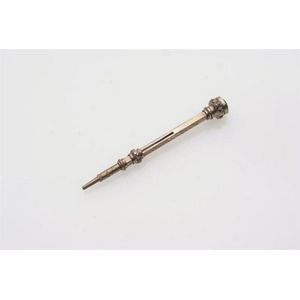
14ct Gold Telescopic Miniature Pencil with Seal Top
A 14ct gold (tested) seal top telescopic miniature pencil, 4 cm long, total weight 2.2gms
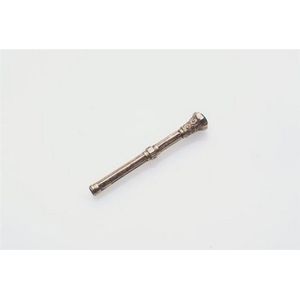
Engraved 9ct Gold Telescopic Pencil with Seal Top
A 9ct gold (hallmarked) seal top telescopic pencil, engraved body, 5.5 cm long, total weight 5.2gms
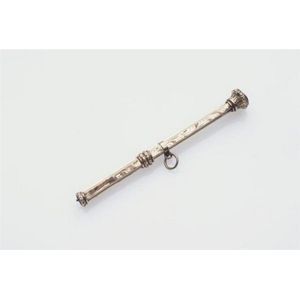
Faceted Seal Top Gold Pencil
A 9ct gold (tested) seal top telescopic pencil, facet cut seal, engraved body, 8 cm long, total weight 7.5gms
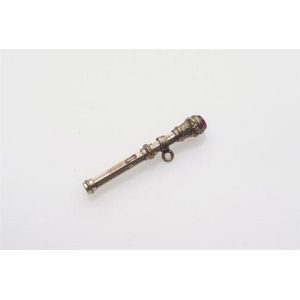
Bloodstone Seal Pencil in Sterling Silver
A miniature seal top telescopic pencil, bloodstone, sterling silver, 4 cm long
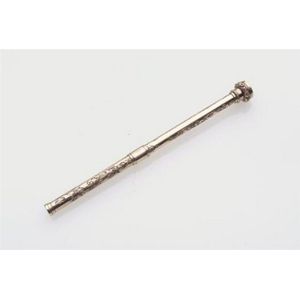
Decorative 9ct Gold Seal Top Telescopic Pencil, 5g
A 9ct gold (tested) seal top telescopic pencil, extensively decorated body, 8 cm long, total weight 5gms
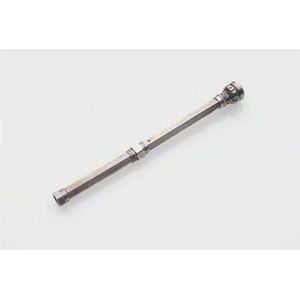
Sterling Silver Seal Top Telescopic Pencil, Engine Turned Body
A seal top telescopic pencil, engine turned body, sterling silver, 8 cm long
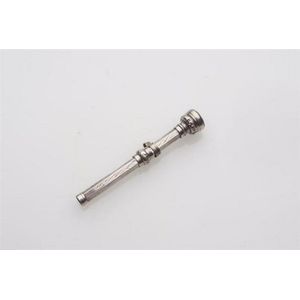
Sterling Silver Telescopic Pencil with Floral Seal Top
A sterling silver seal top telescopic pencil, floral imprint to seal, 4.5 cm long
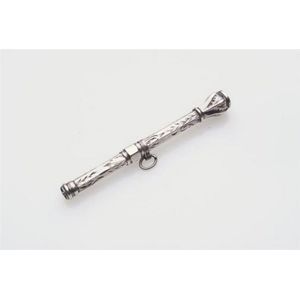
Sterling Silver Amethyst Seal Top Telescopic Pencil
A sterling silver seal top telescopic pencil, amethyst inset, 7.5 cm long

Engraved 9ct Gold Telescopic Pencil with Seal Top
A 9ct gold (tested) seal top telescopic pencil, engraved body, 4.5 cm long, total weight 3gms
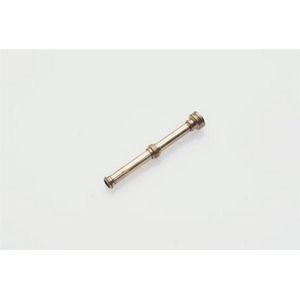
9ct Gold Amethyst Seal Top Telescopic Pencil
A 9ct gold (tested) seal top telescopic pencil, amethyst, of plain form, 4.5 cm long, total weight 3.3gms
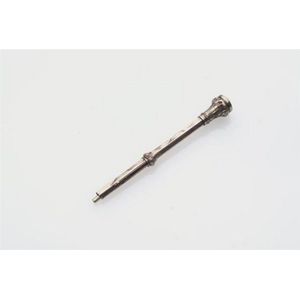
Amethyst Sterling Silver Telescopic Pencil with Engraved Body
A seal top sterling silver telescopic pencil, amethyst, engraved body, 6 cm long
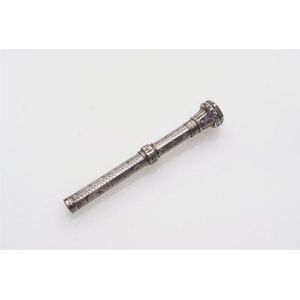
Sterling Silver Amber Pencil with Seal Top
A small sterling silver seal top telescopic pencil, amber inset, 6 cm long
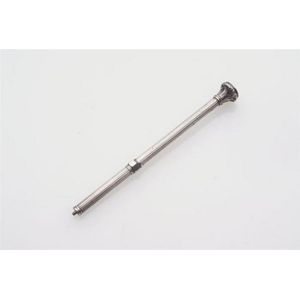
Sterling Silver Seal Top Telescopic Pencil, 8cm Long
A seal top sterling silver telescopic pencil, 8 cm long
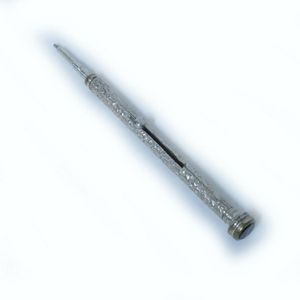
Silver Plated Telescoping Pencil with Agate Seal
Silver plated telescoping pencil, with repousse barrel and banded agate seal end (un-engraved)
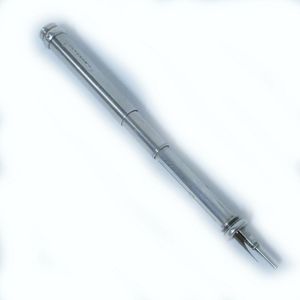
Telescoping Sterling Silver Pencil with Bloodstone Seal
Sterling silver telescoping pencil by S. Mordan & Co., London, c.1860, with unengraved bloodstone seal end.
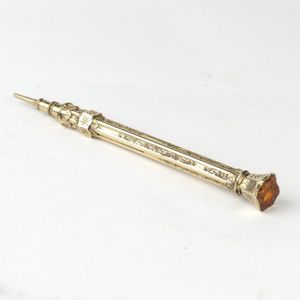
Victorian 9ct. Gold Propelling Pencil with Citrine Seal
A Victorian 9ct. gold propelling pencil, the exterior profusely engraved with a citrine seal to the end, unmarked but tests as 9ct.
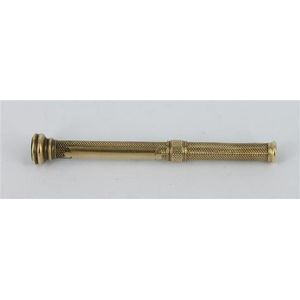
Bloodstone-sealed Rolled-Gold Propelling Pencil
A rolled-gold propelling pencil with bloodstone seal.
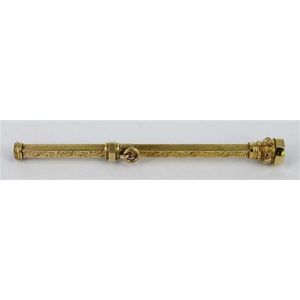
9ct Gold Propelling Pencil with Carnelian Seal
A gold propelling pencil, foliate design and machine turned detail, carnelian seal; testing as 9ct gold. Weight 9.9g.
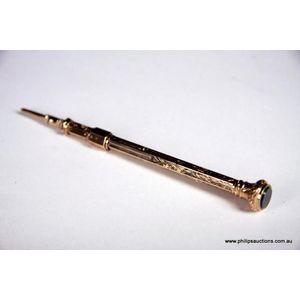
Victorian Rose Gold Propelling Pencil with Foliate Designs
A Victorian 9 carat rose gold propelling pencil, later 19th century, with maker's mark E.B. The hexagonal shaped pencil with chased foliate designs and a turban shaped finial with a stone seal; hallmarked 9C to shaft. Length 12.5 cm

Sampson Mordan 9ct Gold Pencil with Seal
9ct yellow gold Sampson Mordan pencil. Metal mechanism. Seal to top.
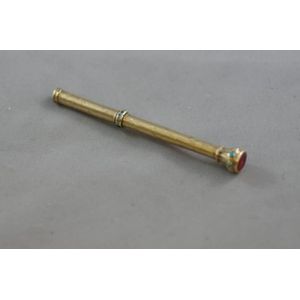
Antique Gold and Turquoise Pencil with Agate Seal
Antique gold and turquoise pencil, with agate seal to top, as inspected.
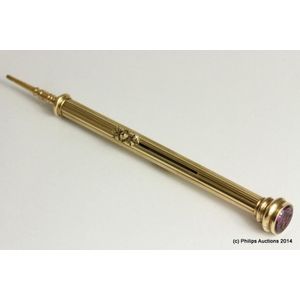
Antique Writing Pencil with Amethyst Seal in Original Box
An antique writing pencil, yellow gold cased, fitted to original box, of cylindrical form with ribbed outer case, flared to one end with set amethyst seal, slide mechanism of foliate design, manufactured by brush & Macdonnell



 Loading more...
Loading more...